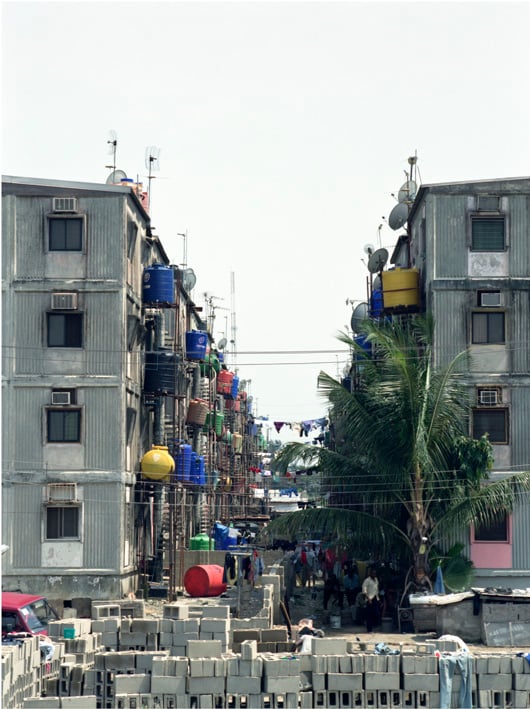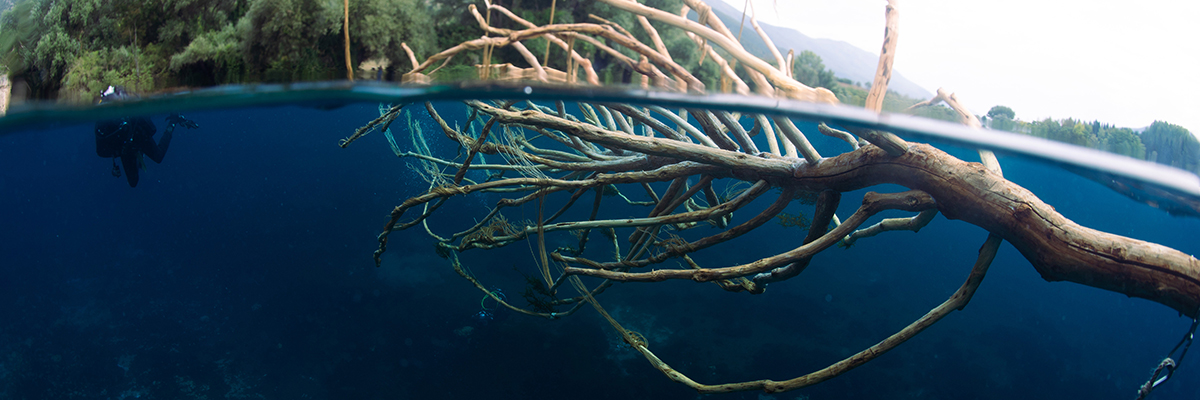Dolphin Estate
2008 - Photography (Photography)
Photograph: Dolphin Estate III, 140 x 110 cm
Otobong Nkanga
Born in 1974, Kano, Nigeria, Otobong Nkanga lives and works in Antwerp, Belgium. Nkanga makes use of different mediums like drawing, performance, photography video or installation to put forward observations and sensations of the everyday influences in our social developments, environment and culture. Her works refers to autobiographical narratives and social ecological realities of spaces of her homeland and places she encounters. Her drawings, installations, photographs, videos and sculptures variously examine ideas around land and the value connected to its resources. In many of her works Nkanga reflects metonymically on the use and cultural value of natural resources, exploring how meaning and function are relative within cultures and revealing different roles and histories for the same products. She edits her own experience and that of her compatriots into purposeful and lucid icons. Mining memory and personal urban biography Nkanga reveals the dialectical relationships between everyday material landscapes and the unseen social, political, and economic structures that shape – and are shaped by – them. A more documentary approach to the consequent interrogation of the implications of human acts and their effects on varied environments and contexts, one can find in Nkanga’s different photographic series Dolphin Estate. The series documents the first prefabricated residential neighbourhood in Lagos, built in the 1990s. In a statement Nkanga recounts that these photographs, taken in 2008, “show the results and conditions of a long lost dream. Dolphin Estate has gradually fallen into a state of disrepair leaving the residents to take care for their daily needs such as water, electricity and deal with flooding problems”. The neo-American suburbian names for the housing complexes seem to suggest a gated community as a utopia in daily life, but in reality the buildings are often not adequately equipped with the facilities they promise and the necessity emerges to build extensions and additional structures to support human survival as a multitude of giant water vessels outside the apartment windows prove. As the photographs show, the makeshift altération between the domestic environment and the vividly coloured barrels infuses an aspect of beauty into a rather dull, concrete environment. Therefore, on a meta-level Dolphin Estates seems to tackle the moral questions connected to the aesthetics of non-architecture and the originality that animates parallel urbanity, as a source of inspiration for artists and architects. Again, as in other works, it is a question that revolves around the paradoxes of exploitation.
Visual artist and performer, Otobong Nkanga’s (b. 1974, Kano, Nigeria) practice weaves together concerns about land, natural resources, architecture and the dynamic status of remembrance. Pivotal to this is examining, representing and altering ideas of geographies, home and displacement. Her multimodal works spans performance, installation, sculpture, drawing, textiles, photography and video. Instead of focusing on the differences between distinct objects and environments, Nkanga focuses on their similarities and connections. For Nkanga, the crucial element of connection is memory, stating: “Memory is not only an autobiographical state, but also an important notion in relation to objects that leave traces”.
Colors:
Other related works, blended automatically
» see more

© » KADIST
Otobong Nkanga
2015Tsumeb Fragments was produced for the exhibition at Kadist, “Comot Your Eyes Make I Borrow You Mine” in 2015...
Related works sharing similar palette
» see more

© » KADIST
Koki Tanaka
2010Tanaka’s unique understanding of objects and materials is reflected in the four photographs that document his Process of Blowing Flour ...

© » ARTNEWS CN
Invisible Ink – ARTnews.com Skip to main content By Richard Vine Plus Icon Richard Vine Managing Editor, Art in America View All March 3, 2014 2:10am View Gallery 6 Images “ Ink Art: Past as Present in Contemporary China ,” now at New York’s Metropolitan Museum of Art , seems at first to be a long-awaited corrective to Western myopia in regard to Chinese ink painting and calligraphy...
Other works by: » Otobong Nkanga
» see more

© » KADIST
Otobong Nkanga
2015Tsumeb Fragments was produced for the exhibition at Kadist, “Comot Your Eyes Make I Borrow You Mine” in 2015...
Related works found in the same semantic group
» see more

© » KADIST
Hama Goro
Hama Goro works with a traditional method called the Bogolan technique, which is inspired by a method used in Mali to color clothes...

© » KADIST
Abraham Oghobase
2018This series of photographs is inspired by the artist’s travels to Jos, Nigeria...

© » KADIST
Abraham Oghobase
2018This series of photographs is inspired by the artist’s travels to Jos, Nigeria...



